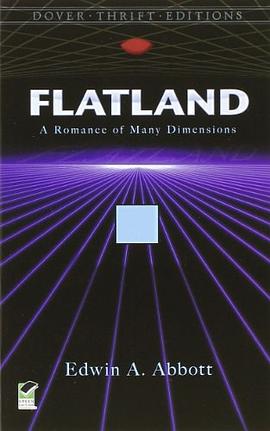

具体描述
'Upward, yet not Northward.' How would a creature limited to two dimensions be able to grasp the possibility of a third? Edwin A. Abbott's droll and delightful 'romance of many dimensions' explores this conundrum in the experiences of his protagonist, A Square, whose linear world is invaded by an emissary Sphere bringing the gospel of the third dimension on the eve of the new millennium. Part geometry lesson, part social satire, this classic work of science fiction brilliantly succeeds in enlarging all readers' imaginations beyond the limits of our 'respective dimensional prejudices'. In a world where class is determined by how many sides you possess, and women are straight lines, the prospects for enlightenment are boundless, and Abbott's hypotheses about a fourth and higher dimensions seem startlingly relevant today. This new edition of Flatland illuminates the social and intellectual context that produced the work as well as the timeless questions that it raises about the limits of our perception and knowledge. --This text refers to an out of print or unavailable edition of this title.
作者简介
From Biography Base:
Edwin Abbott Abbott, English schoolmaster and theologian, is best known as the author of the mathematical satire Flatland (1884).
He was educated at the City of London School and at St John's College, Cambridge, where he took the highest honours in classics, mathematics and theology, and became fellow of his college. In 1862 he took orders. After holding masterships at King Edward's School, Birmingham, and at Clifton College, he succeeded G. F. Mortimer as headmaster of the City of London School in 1865 at the early age of twenty-six. He was Hulsean lecturer in 1876.
He retired in 1889, and devoted himself to literary and theological pursuits. Dr. Abbott's liberal inclinations in theology were prominent both in his educational views and in his books. His Shakespearian Grammar (1870) is a permanent contribution to English philology. In 1885 he published a life of Francis Bacon. His theological writings include three anonymously published religious romances - Philochristus (1878), Onesimus (1882), and Sitanus (1906).
More weighty contributions are the anonymous theological discussion The Kernel and the Husk (1886), Philomythus (1891), his book The Anglican Career of Cardinal Newman (1892), and his article "The Gospels" in the ninth edition of the Encyclopædia Britannica, embodying a critical view which caused considerable stir in the English theological world. He also wrote St Thomas of Canterbury, his Death and Miracles (1898), Johannine Vocabulary (1905), Johannine Grammar (1906). Flatland was published in 1884.
Sources that say he is the brother of Evelyn Abbott (1843 - 1901), who was a well-known tutor of Balliol College, Oxford, and author of a scholarly history of Greece, are in error.
目录信息
Section
1. Of the Nature of Flatland
2. Of the Climate and Houses in Flatland
3. Concerning the Inhabitants of Flatland
4. Concerning the Women
5. Of our Methods of Recognizing one another
6. Of Recognition by Sight
7. Concerning Irregular Figures
8. Of the Ancient Practice of Painting
9. Of the Universal Colour Bill
10. Of the Suppression of the Chromatic Sedition
11. Concerning our Priests
12. Of the Doctrine of our Priests
PART II: OTHER WORLDS
13. How I had a Vision of Lineland
14. How I vainly tried to explain the nature of Flatland
15. Concerning a Stranger from Spaceland
16. How the Stranger vainly endeavoured to reveal to me
in words the mysteries of Spaceland
17. How the Sphere, having in vain tried words,
resorted to deeds
18. How I came to Spaceland, and what I saw there
19. How, though the Sphere shewed me other mysteries
of Spaceland, I still desired more; and what came of it
20. How the Sphere encouraged me in a Vision
21. How I tried to teach the Theory of Three Dimensions
to my Grandson, and with what success
22. How I then tried to diffuse the Theory
of Three Dimensions by other means, and of the result
· · · · · · (收起)
读后感
1、英国人的幽默感总是与众不同,埃德温·A·艾伯特1884年的《平面国》今天看起来仍然充满现实的讽喻,前半本整个就是个数学版本的《1984》,而且更加精干和一针见血。看到圆形教士镇压不规则形领导煽动等腰三角形起义,要求获得平等,觉得如此熟悉。 2、而后半本则提出了更宏...
评分 评分经历过20世纪初的科学大爆炸后的人们可能不易为然,但是在我,却为这本书感到惊讶。很难想象在1884年,距离普朗克提出量子理论还有16年,距离爱因斯坦创立狭义相对论还有21年,竟然有人写出了这样一本小书。要知道,当时,科学精英们为代表的人类的骄傲已经达到了顶峰,从牛顿...
评分经历过20世纪初的科学大爆炸后的人们可能不易为然,但是在我,却为这本书感到惊讶。很难想象在1884年,距离普朗克提出量子理论还有16年,距离爱因斯坦创立狭义相对论还有21年,竟然有人写出了这样一本小书。要知道,当时,科学精英们为代表的人类的骄傲已经达到了顶峰,从牛顿...
评分经历过20世纪初的科学大爆炸后的人们可能不易为然,但是在我,却为这本书感到惊讶。很难想象在1884年,距离普朗克提出量子理论还有16年,距离爱因斯坦创立狭义相对论还有21年,竟然有人写出了这样一本小书。要知道,当时,科学精英们为代表的人类的骄傲已经达到了顶峰,从牛顿...
用户评价
定的是这个版本 送来的是dover版 一口气看完 傻傻坐在那幻想了好久
评分谢耳朵喜欢的二维世界,《生活大爆炸》里的点评鞭辟入里,本书是对维多利亚道德风尚的隐晦批评。
评分Well,其实更像是现实讽刺小说
评分唯一买过的英文书籍。。。。。。。。。。。。。。。。。。。
评分很简短的一本小书,验证了经验造成的思维局限。
相关图书
本站所有内容均为互联网搜索引擎提供的公开搜索信息,本站不存储任何数据与内容,任何内容与数据均与本站无关,如有需要请联系相关搜索引擎包括但不限于百度,google,bing,sogou 等
© 2025 book.wenda123.org All Rights Reserved. 图书目录大全 版权所有




















